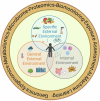Exposomics: a review of methodologies, applications, and future directions in molecular medicine
- PMID: 39870881
- PMCID: PMC11982546
- DOI: 10.1038/s44321-025-00191-w
Exposomics: a review of methodologies, applications, and future directions in molecular medicine
Abstract
The exposome is the measure of all the exposures of an individual in a lifetime and how those exposures relate to health. Exposomics is the emerging field of research to measure and study the totality of the exposome. Exposomics can assist with molecular medicine by furthering our understanding of how the exposome influences cellular and molecular processes such as gene expression, epigenetic modifications, metabolic pathways, and immune responses. These molecular alterations can aid as biomarkers for the diagnosis, disease prediction, early detection, and treatment and offering new avenues for personalized medicine. Advances in high throughput omics and other technologies as well as increased computational analytics is enabling comprehensive measurement and sophisticated analysis of the exposome to elucidate their cumulative and combined impacts on health, which can enable individuals, communities, and policymakers to create programs, policies, and protections that promote healthier environments and people. This review provides an overview of the potential role of exposomics in molecular medicine, covering its history, methodologies, current research and applications, and future directions.
Keywords: Environmental Exposures; Exposomics; Omics; Risk Assessment.
© 2025. The Author(s).
Conflict of interest statement
Disclosure and competing interests statement. XZ is a cofounder of Exposomics, Inc. MPS is a cofounder and scientific advisor of Crosshair Therapeutics, Exposomics, Filtricine, Fodsel, iollo, InVu Health, January AI, Marble Therapeutics, Mirvie, Next Thought AI, Orange Street Ventures, Personalis, Protos Biologics, Qbio, RTHM, SensOmics. MPS is a scientific advisor of Abbratech, Applied Cognition, Enovone, Jupiter Therapeutics, M3 Helium, Mitrix, Neuvivo, Onza, Sigil Biosciences, TranscribeGlass, WndrHLTH, Yuvan Research. MPS is a cofounder of NiMo Therapeutics. MPS is an investor and scientific advisor of R42 and Swaza. MPS is an investor in Repair Biotechnologies. All other authors declare no conflict of interest.
Figures


References
-
- Babu M, Lautman Z, Lin X, Sobota MHB, Snyder MP (2024) Wearable devices: implications for precision medicine and the future of health care. Annu Rev Med 75:401–415 - PubMed
Publication types
MeSH terms
Grants and funding
- UM1 AI109565/AI/NIAID NIH HHS/United States
- R21 AI149277/AI/NIAID NIH HHS/United States
- R01 HL141851/HL/NHLBI NIH HHS/United States
- R01 AI125567/AI/NIAID NIH HHS/United States
- P01 HL152953/HL/NHLBI NIH HHS/United States
- P01 HL152953,R01 HL141851/HHS | NIH | National Heart, Lung, and Blood Institute (NHLBI)
- R01 ES032253/ES/NIEHS NIH HHS/United States
- R21AI1492771,R21EB030643,U01AI140498,U01 AI147462,R01AI140134,UM1AI109565,UM2AI130836,P01AI15/HHS | NIH | National Institute of Allergy and Infectious Diseases (NIAID)
- R21 EB030643/EB/NIBIB NIH HHS/United States
- P01 AI153559/AI/NIAID NIH HHS/United States
- R01 AI140134/AI/NIAID NIH HHS/United States
- R21ES03304901,R01ES032253/HHS | NIH | National Institute of Environmental Health Sciences (NIEHS)
- U19 AI167903/AI/NIAID NIH HHS/United States
- UM2 AI130836/AI/NIAID NIH HHS/United States
- U01 AI147462/AI/NIAID NIH HHS/United States
- U01 AI140498/AI/NIAID NIH HHS/United States
- T32 HL007118/HL/NHLBI NIH HHS/United States
LinkOut - more resources
Full Text Sources

